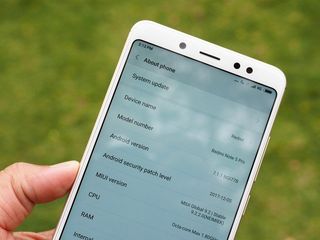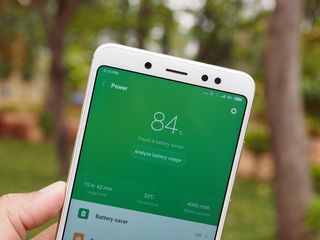Xiaomi can do no wrong in India. The manufacturer sold nearly 10 million units of the Redmi Note 4 in the country last year, and is looking to maintain that momentum with the Redmi Note 5 Pro.
Xiaomi built its entire business model on offering great value for money — and as the sales numbers indicate, the strategy has paid off handsomely for the brand. But following up on the Redmi Note 4 is a tough act, as there wasn't much wrong with the device.
That's why with its 2018 budget phone, Xiaomi is focusing on core upgrades in all the major areas. The Redmi Note 5 Pro introduces an 18:9 display, a dual camera at the back and a 20MP front camera with LED flash, a Snapdragon 636 chipset, and up to 6GB of RAM. Xiaomi led the category for battery life last year, and things aren't any different this year — the Redmi Note 5 Pro has a 4000mAh battery.
With the competition also fielding increasingly powerful phones, does the Redmi Note 5 Pro have what it takes to further Xiaomi's cause in India? It's time to find out.

Xiaomi Redmi Note 5 Pro Specs
| Category | Features |
|---|---|
| Operating System | MIUI 9.2 based on Android 7.1.1 Nougat |
| Display | 5.99-inch 18:9 FHD+ (2160x1080) IPS LCD panel403ppi pixel density450nits maximum brightness |
| SoC | Octa-core Qualcomm Snapdragon 636Eight Kryo 260 cores up to 1.8GHz14nm |
| GPU | Adreno 509 |
| RAM | 4GB/6GB |
| Storage | 64GB/64GBmicroSD slot up to 128GB |
| Rear camera | 12MP with 1.25um pixel size and f/2.2 lens + 5MP with 1.12um pixel size and f/2,0 lensPDAF, LED flash1080p video recording |
| Front shooter | 20MP with LED Selfie light1080p video recording |
| Connectivity | LTE with VoLTEWi-Fi 802.11 ac, Bluetooth 5.0, GPS, GLONASSMicro-USB, 3.5mm audio jack, IR blaster |
| Networks | LTE: 1/3/5/40/41GSM: 2/3/5/8WCDMA: 1/2/5/8 |
| Battery | 4000mAh batteryFast charging (5V/2A) |
| Fingerprint | Rear fingerprint sensor |
| Dimensions | 158.6 × 75.4 × 8.05mm |
| Weight | 181g |
| Colors | Gold, Rose Gold, Blue, Black |
About this review
I (Harish Jonnalagadda) am writing this review after using the Redmi Note 5 Pro for over two weeks in Hyderabad, India. The device is a pre-production unit provided by Xiaomi India and is running a nightly build of MIUI 9 (9.2.2.0). I tested the phone on Airtel and Jio's 4G networks in Hyderabad.
Xiaomi Redmi Note 5 Pro Design
The Redmi Note 5 Pro marks Xiaomi's foray into the 18:9 form factor in the budget segment. The brand led the way for bezel-less panels with the Mi Mix and the Mi Mix 2, and while the effect isn't anywhere as striking on the Redmi Note 5 Pro, you do get a taller 5.99-inch display with significantly reduced bezels when compared to last year's Redmi Note 4.
The switch to an 18:9 panel also means there's an all-new design up front. The capacitive navigation buttons have made way for on-screen keys, and you can change the orientation of the back and overview buttons from the settings menu.
Round back, things are more familiar. If you ignore the camera module, the Redmi Note 5 Pro is identical to the Redmi Note 5, which in turn shares the same design aesthetic as the Redmi Note 4. The Redmi Note 4 had an iterative design that was nearly identical to the Redmi Note 3, so what we have here is a design language that's three years old.





Like previous years, the antenna inlays at the top and bottom of the device are made out of plastic, but feature a metallic finish. There's a minor variance in color between the inlays and the metal back, particularly on the gold version. It isn't as noticeable on the other color options of the device.
While the aesthetic has evolved over the last three years, the design at the back is starting to look stale. The design works for the Redmi Note 5, which starts off at ₹9,999, but it would've made more sense for Xiaomi to differentiate the Redmi Note 5 Pro from the standard variant.
Talking about lack of differentiation from the Redmi Note 5, the Note 5 Pro also comes with a microUSB charging port. The standard is becoming outdated, and the onus is now on Xiaomi to make the switch to USB-C in the Redmi series. That said, the IR blaster is intact, as is the 3.5mm jack. The volume and power buttons offer a decent amount of tactile feedback as well.
The 18:9 panel up front is one of the best in the budget segment.
The fingerprint sensor at the back is identical to what Xiaomi has used in the past, and it is quick to authenticate and the positioning is just right. The sensor is located in the top one-third section and is right next to the natural resting position of your index finger. There's also a more prominent curve where the back meets the mid-frame, leading to better in-hand feel.
Coming to the display, the 5.99-inch LCD panel is one of the best in this segment. Xiaomi has made a habit of offering vibrant displays in this category, and the same is true for the Redmi Note 5 Pro as well. The panel offers a resolution of 2160x1080, which is becoming the standard for the 18:9 form factor.
Colors out of the box are excellent, and you can tweak the settings to your preferences by going into the settings. The phone also comes with a blue light filter that can be configured to automatically kick in from sunset to sunrise. If you're one to use your phone a lot during the night, you should enable the feature as it reduces strain on the eyes.
For better or worse, the camera sensor — with the lenses arrayed vertically and the flash tucked in between — is identical to that of the iPhone X. It protrudes from the back as well, which makes the phone wobble when laid on a flat surface like a table.
Overall though, the build quality as well as fit and finish are all top-notch, with Xiaomi undertaking stricter quality control measures. At 181g, the Redmi Note 5 Pro is heavier than its predecessors, and the taller panel doesn't make it conducive to use one-handed.

Xiaomi Redmi Note 5 Pro Hardware
Xiaomi is regularly in the first wave of manufacturers to roll out Qualcomm's latest hardware. We've seen that in years past, and that's the case with the Redmi Note 5 Pro as well, which is the first device to be powered by Qualcomm's Snapdragon 636 mobile platform.
The Snapdragon 636 is interesting as it introduces Kryo cores to the budget category. The Snapdragon 660 did the same for the mid-range segment last year, but a majority of the phones powered by the chipset — the OPPO R11 and the Xiaomi Mi Note 3 — were limited to the Chinese market.
The Snapdragon 636 features eight cores in total, with four performance cores complemented by four energy-efficient cores. We've seen that same combination in use in the Android space for a few years now, and it strikes the ideal balance between performance and energy efficiency.
The four high-performance cores are based on ARM's Cortex A73, one of the fastest cores available today. The energy-efficient cores are based on the Cortex A53, a mainstay in the budget segment over the last two years. Qualcomm has offered fully custom cores in the Kryo platform before, but it is leveraging the "Built on ARM Cortex Technology" licensing agreement to build semi-custom cores.
The Redmi Note 5 Pro is on par with flagship chipsets from just a few years ago.
The license allows Qualcomm to take off-the-shelf Cortex cores and make modifications to tweak the overall performance. We've seen Qualcomm go down this road with the Snapdragon 820, 821, and the 835, and the chip vendor is now doing the same for the downstream Snapdragon chipsets. Going with a Cortex license has several benefits as it gives Qualcomm the ability to go to market faster — it doesn't need to design a core from the ground-up — while retaining a competitive advantage.
Coming back to the Redmi Note 5 Pro, the Kryo cores make a tangible difference in terms of overall performance. You're looking at anywhere from a 15-20% increase in CPU speeds and a 10% uptick in GPU performance. As we've seen in the benchmarks, the Snapdragon 636 is an underclocked version of the Snapdragon 660, which delivers performance equivalent to flagship chipsets from just a few years ago.
The performance on tap with the Redmi Note 5 Pro is nothing short of extraordinary, and it's safe to say that this is the fastest phone in the budget segment by some margin. The GPU performance means that the phone can now handle visually intensive games as well, which was a limitation with last year's Redmi Note 4.
Xiaomi Redmi Note 5 Pro benchmarks
The Redmi Note 5 Pro is also decked out with LPDDR4X RAM, which thus far has been limited to the high-end segment. It would've been great had the device offered UFS storage as well, but the global demand for storage meant it wasn't viable for Xiaomi to include it in the Redmi Note 5 Pro. The phone instead features eMMC 5.0 storage, and with both variants offering 64GB of internal memory, you're not going to run out anytime soon.
Also new with the Redmi Note 5 Pro is Wi-Fi ac as well as Bluetooth 5.0, with both features limited to the Pro variant and not available in the standard version. Talking about connectivity, the Redmi Note 5 Pro had no issues with calls, and the speaker at the bottom is astonishingly loud. In short, if you're looking for the most bang for your buck in the budget segment, this is the phone to get.
Battery life

Xiaomi prioritized the battery segment last year, introducing a 4100mAh battery in the Redmi Note 4. The huge battery combined with MIUI's optimizations allowed the Redmi Note 4 to run rings around its rivals. A year on, that hasn't changed. While the Redmi Note 5 Pro has a marginally smaller 4000mAh battery, you're guaranteed the same great class-leading battery life.
You'll easily get a day-and-a-half worth of usage from that battery consistently, even if you're a power user and rely on your mobile primarily for your entertainment needs. In my usage, I averaged nine hours of screen-on-time spread over two days.
My main issue with the battery on the Redmi Note 5 Pro is the lack of fast charging. With the battery easily lasting more than a day on average, more often than not you'll be looking to top up your device in the middle of the day, and that poses problems as the bundled charger maxes out at 5V/2A. The phone itself is not compatible with fast charging, taking an agonizing two hours to get from zero to a full charge.
Fast charging isn't a big deal on a device with such great battery life, but the lack thereof is one of the few areas where the Redmi Note 5 Pro is behind the competition.

Xiaomi Redmi Note 5 Pro Software
On the software front, it's business as usual. The Redmi Note 5 Pro comes with the latest version of MIUI 9, but if you were hoping for Oreo, get ready to be disappointed. The phone is still based on Android 7.1.1 Nougat, with an Oreo update slated for sometime later this year.
Furthermore, with the Redmi Note 5 Pro being the first to run the Snapdragon 636, there are odd glitches along the way. My unit is on the nightly 9.2.2.0 build, and the stable 9.2.4.0 update is scheduled to make its way to the phone shortly after its release. The stable build should iron out the kinks and allow the phone to take full advantage of the Snapdragon 636.
Optimization could also be the reason why Xiaomi stuck with the Snapdragon 625 for the standard version of the Redmi Note 5. The manufacturer has been optimizing the chipset for well over a year now, to the point where it runs with nary a lag or stutter. It'll take a few weeks at least to get the Redmi Note 5 Pro to the same level, following which we'll hopefully see the Oreo update make its way to the device.
MIUI is a ROM that needed a visual refresh yesterday.
Apart from the lack of Oreo, the user experience on offer with the Redmi Note 5 Pro is similar to Xiaomi devices released over the course of the last twelve months. There's a ton of customization options and more features than you'll end up using, but that's one of the main draws of MIUI. Xiaomi has invested considerable resources in building out features, and MIUI 9 has plenty to offer in the form of quick replies in the notification window, an all-new Mi Video app, native split-screen functionality, and much more.
Then there's older features like Dual Apps — which let you run two instances of an app simultaneously — and Second Space, through which you'll be able to create a separate profile on your device. The SMS app has been tailored for Indian customers, taking the information from a ticket confirmation SMS and automatically creating a card with all the relevant details highlighted.
MIUI 9: Nine new features you need to know
As I said last year, MIUI is never going to adhere to "pure" Android in terms of a visual layout, and that's because a majority of its users are in China. The unregulated nature of the Chinese app market is what led to features like a dedicated Security app and granular control over autostart permissions.
But with usage vastly increasing in markets like India, we may see a wholesale change heading to MIUI in the coming years. The retooled notification pane is definitely a step in the right direction, but the interface as a whole is in need of a refresh to make it more modern. The recents menu, for instance, hasn't changed from the KitKat era, and if you need an app drawer, you'll need to look to a third-party launcher. Xiaomi will hopefully address these issues and make much-needed changes to MIUI sooner rather than later.

Xiaomi Redmi Note 5 Pro Camera
If you ignore the fact that the dual-lens arrangement at the back is identical to that of the iPhone X, there's plenty to like in the Redmi Note 5 Pro's camera. The phone features a 12MP primary camera that's joined by a secondary 5MP depth camera, and up front you get a 20MP camera with LED flash.
The Redmi Note 5 Pro does a stunning job in daylight conditions, with images offering plenty of detail and accurate colors. HDR is off by default, and while the mode was more of a hindrance in past Redmi devices, it's actually usable in the Redmi Note 5 Pro. Finally, the phone does a decent job in low-light conditions, which is a huge deal seeing as how most budget phones struggle in this area.
The camera on the Redmi Note 5 Pro beats other phones in this category by a country mile.
I put the phone to the test by using it as my daily driver during Xiaomi's launch event earlier this month, and came away impressed with the overall results. I normally rely on either the Pixel 2 XL or the Note 8 for launch event coverage as the lighting at these venues isn't ideal, but the Redmi Note 5 Pro did an admirable job.
The dual camera setup also enables portrait mode, which we've seen in the Mi 6 and more recently the Mi A1. The background blur effect is more conservative this time around, but as Xiaomi pointed out at the launch event, its edge detection algorithm is spot-on.












On the video front, you get electronic image stabilization, but miss out on 4K recording. It's unclear why the feature was removed as the Snapdragon 636 can handle 4K video, and as good as the Redmi Note 5 Pro is at taking photos, videos aren't the device's forte.
Sure, the Redmi Note 5 Pro won't blow the Note 8 out of the water, but you have to remember that the phone is available for less than one-fourth the price of Samsung's flagship.

Should you buy it? Absolutely
The Redmi Note 5 Pro is Xiaomi's strongest showing in the budget segment in the last two years, and puts the brand in a great position as we head into the launch cycle for 2018. The 18:9 display is a much-needed change to keep the device competitive, and the Snapdragon 636 ensures class-leading performance for the foreseeable future.
This is the first Redmi device I'd consider using as my daily driver.
The Redmi Note 5 Pro is the first phone in the Redmi series I'd consider using as my daily driver. Previous phones in this series weren't short on power, but the camera was the one area where Xiaomi lagged behind.
The phone is offered in two variants — a model with 4GB of RAM and 64GB of storage, and a version with 6GB of RAM and 64GB of storage. The 4GB model retails for ₹13,999 and is on sale, and the 6GB version is available for ₹16,999. The phone should be making its way to Xiaomi's offline partners shortly after its launch, and head to the 22 Mi Home stores in the country.
The Good
- 18:9 display
- Class-leading camera
- Powerful hardware
- Two-day battery life
- Unmatched value for money
The Bad
- Availability
- No Oreo
4.5 out of 5
With the Redmi Note 5 Pro, the manufacturer is taking the lead in the budget segment, and once again setting the benchmark for the rest of the field to follow. If you're in the market for a budget phone, the Redmi Note 5 Pro should be at the top of your list. The combination of sheer hardware combined with the great camera, two-day battery life, and 18:9 panel makes the Redmi Note 5 Pro the device to beat in this category.

Harish Jonnalagadda is Android Central's Senior Editor of Asia. In his current role, he oversees the site's coverage of Chinese phone brands, networking products, and AV gear. He has been testing phones for over a decade, and has extensive experience in mobile hardware and the global semiconductor industry. Contact him on Twitter at @chunkynerd.

Heads up! This Black Friday Meta Quest 3S deal gives you OVER $140 worth of free stuff — I'm not kidding

Ditch tablets — you can get a whole laptop for just $160 with this amazing Black Friday Chromebook deal

Hear me out: our favorite headphones just crashed back to their lowest price EVER during Amazon's Black Friday deals
